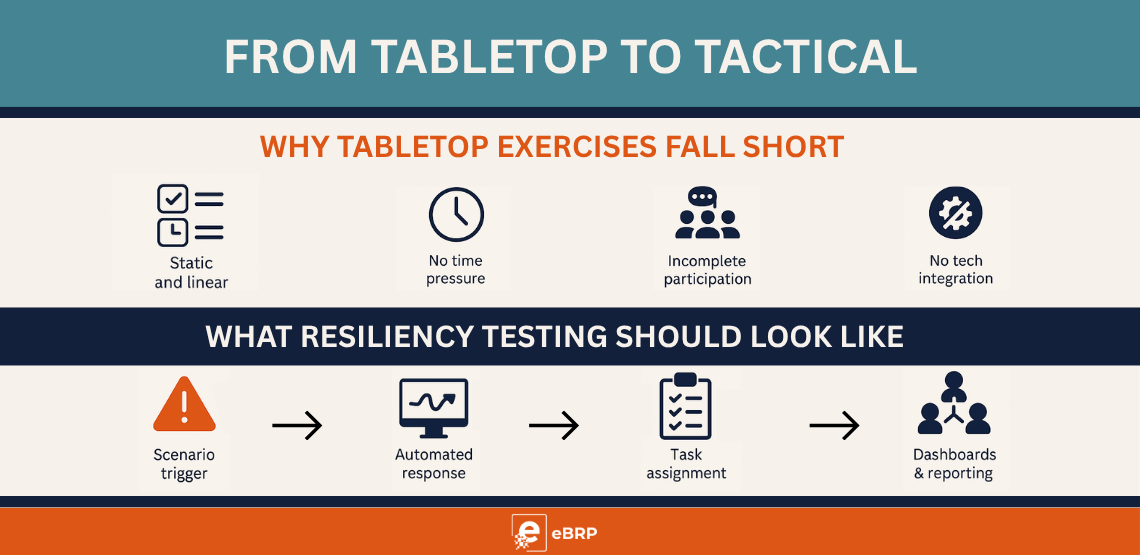In the world of Enterprise Resiliency, being “ready” isn’t just about having a plan—it’s about demonstrating that the plan performs under pressure. For many organizations, tabletop exercises have long been the default method for testing continuity and incident response plans. These informal simulations, where team members discuss their roles in a hypothetical scenario, serve as valuable awareness tools. However, in today’s volatile and high-stakes risk environment, they fall short of what’s truly required.
Tabletop exercises are inherently limited. They typically involve static scenarios—often based on one predefined event—lacking the complexity and unpredictability of real-life disruptions. There’s no real-time pressure, so teams aren’t tested on their ability to act swiftly under stress or when juggling multiple priorities. Participation is often inconsistent, excluding key cross-functional stakeholders like IT, HR, or finance, which diminishes the realism and completeness of the test. More critically, these exercises rarely integrate the very tools that would be used during an actual incident—communication platforms, task management systems, or response dashboards. As a result, the outcomes are often anecdotal, and improvements, if any, are not measured or sustained. In short, tabletop exercises validate awareness—not operational capability.
To truly evaluate an organization’s readiness, resiliency testing must move beyond conversation into execution. This requires a framework that is comprehensive, data-driven, and operational. Modern resiliency testing begins with scenario-based simulations grounded in real threat models, such as cyberattacks, utility failures, vendor outages, or pandemics. These scenarios should include evolving conditions—like cascading impacts or shifting resource availability—to more accurately mirror the chaos of real disruptions.
Execution should be technology-enabled. Platforms like eBRP’s CommandCentre allow organizations to initiate live incident responses, activate notifications, assign tasks, and facilitate cross-team collaboration using integrated tools like Microsoft Teams, SMS, and email. Importantly, testing should validate a plan’s status control functionality—the ability to initiate, pause, escalate, or close plans across various departments and geographies. This includes verifying Gantt-style task timelines, role-based assignments, and interdependencies. True testing must also include multi-team orchestration, engaging not just recovery plan owners but also executive sponsors and operational teams from IT to communications.
A strong resiliency testing program also emphasizes data collection and analytics. By capturing response times, completion rates, escalation events, and communication logs, organizations gain the insights needed to identify capability gaps and improve future response. This is where eBRP’s testing ecosystem excels. It supports both scheduled and on-demand simulations, offers automated plan triggers, and tracks plan status (Active, Paused, Closed) in real time. Role-specific dashboards, integrated review workflows, and after-action reporting ensure that every exercise feeds directly into a process of continuous improvement.
Over time, organizations can progress through a maturity model of resiliency testing. At the Awareness level, they rely solely on tabletop exercises. At the Capability stage, they begin running real-time simulations and activating live plans. Integration marks the point where organizations can orchestrate multiple plans across teams and business units simultaneously. At the Optimization level, testing is powered by automated triggers and reviewed through dynamic dashboards. Finally, at the Culture stage, resiliency testing becomes a routine part of operations—embedded in business rhythm and decision-making.
Ultimately, tabletop exercises are a start—but they are not a strategy. As threats grow in complexity and regulatory demands rise, enterprises must elevate their readiness efforts. By embracing operationalized, technology-powered testing, organizations build the muscle memory needed to respond under pressure, validate their resilience in real conditions, and safeguard what matters most: mission continuity.


